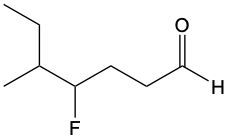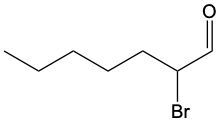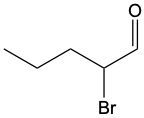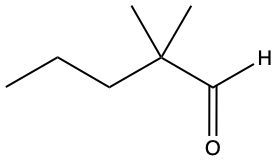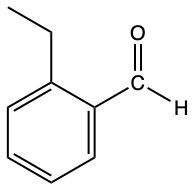Now recall that aldehydes possess a carbonyl carbon connected to an H atom. The set of rules for naming aldehydes is similar to ketones. The exception here, though, is that the carbonyl carbon of the aldehyde is always numbered 1. So that's where we're going to start numbering our longest carbon chain, at the carbonyl carbon of the aldehyde. Here, because we have an aldehyde, a new functional group, we're going to have to modify our ending. We're going to modify the 'e' ending of the original alkane name to 'al', because it's an aldehyde. In terms of our naming convention, we'd still have to give the locations of our substituents, the numerical locations. We'd have to check our parent name with its modified ending, where we're changing 'e' to 'al'. So keep this in mind as we investigate all these different types of aldehydes.
- 1. Matter and Measurements4h 29m
- What is Chemistry?5m
- The Scientific Method9m
- Classification of Matter16m
- States of Matter8m
- Physical & Chemical Changes19m
- Chemical Properties8m
- Physical Properties5m
- Intensive vs. Extensive Properties13m
- Temperature (Simplified)9m
- Scientific Notation13m
- SI Units (Simplified)5m
- Metric Prefixes24m
- Significant Figures (Simplified)11m
- Significant Figures: Precision in Measurements7m
- Significant Figures: In Calculations19m
- Conversion Factors (Simplified)15m
- Dimensional Analysis22m
- Density12m
- Specific Gravity9m
- Density of Geometric Objects19m
- Density of Non-Geometric Objects9m
- 2. Atoms and the Periodic Table5h 23m
- The Atom (Simplified)9m
- Subatomic Particles (Simplified)12m
- Isotopes17m
- Ions (Simplified)22m
- Atomic Mass (Simplified)17m
- Atomic Mass (Conceptual)12m
- Periodic Table: Element Symbols6m
- Periodic Table: Classifications11m
- Periodic Table: Group Names8m
- Periodic Table: Representative Elements & Transition Metals7m
- Periodic Table: Elemental Forms (Simplified)6m
- Periodic Table: Phases (Simplified)8m
- Law of Definite Proportions9m
- Atomic Theory9m
- Rutherford Gold Foil Experiment9m
- Wavelength and Frequency (Simplified)5m
- Electromagnetic Spectrum (Simplified)11m
- Bohr Model (Simplified)9m
- Emission Spectrum (Simplified)3m
- Electronic Structure4m
- Electronic Structure: Shells5m
- Electronic Structure: Subshells4m
- Electronic Structure: Orbitals11m
- Electronic Structure: Electron Spin3m
- Electronic Structure: Number of Electrons4m
- The Electron Configuration (Simplified)22m
- Electron Arrangements5m
- The Electron Configuration: Condensed4m
- The Electron Configuration: Exceptions (Simplified)12m
- Ions and the Octet Rule9m
- Ions and the Octet Rule (Simplified)8m
- Valence Electrons of Elements (Simplified)5m
- Lewis Dot Symbols (Simplified)7m
- Periodic Trend: Metallic Character4m
- Periodic Trend: Atomic Radius (Simplified)7m
- 3. Ionic Compounds2h 18m
- Periodic Table: Main Group Element Charges12m
- Periodic Table: Transition Metal Charges6m
- Periodic Trend: Ionic Radius (Simplified)5m
- Periodic Trend: Ranking Ionic Radii8m
- Periodic Trend: Ionization Energy (Simplified)9m
- Periodic Trend: Electron Affinity (Simplified)8m
- Ionic Bonding6m
- Naming Monoatomic Cations6m
- Naming Monoatomic Anions5m
- Polyatomic Ions25m
- Naming Ionic Compounds11m
- Writing Formula Units of Ionic Compounds7m
- Naming Ionic Hydrates6m
- Naming Acids18m
- 4. Molecular Compounds2h 18m
- Covalent Bonds6m
- Naming Binary Molecular Compounds6m
- Molecular Models4m
- Bonding Preferences6m
- Lewis Dot Structures: Neutral Compounds (Simplified)8m
- Multiple Bonds4m
- Multiple Bonds (Simplified)6m
- Lewis Dot Structures: Multiple Bonds10m
- Lewis Dot Structures: Ions (Simplified)8m
- Lewis Dot Structures: Exceptions (Simplified)12m
- Resonance Structures (Simplified)5m
- Valence Shell Electron Pair Repulsion Theory (Simplified)4m
- Electron Geometry (Simplified)8m
- Molecular Geometry (Simplified)11m
- Bond Angles (Simplified)11m
- Dipole Moment (Simplified)15m
- Molecular Polarity (Simplified)7m
- 5. Classification & Balancing of Chemical Reactions3h 17m
- Chemical Reaction: Chemical Change5m
- Law of Conservation of Mass5m
- Balancing Chemical Equations (Simplified)13m
- Solubility Rules16m
- Molecular Equations18m
- Types of Chemical Reactions12m
- Complete Ionic Equations18m
- Calculate Oxidation Numbers15m
- Redox Reactions17m
- Spontaneous Redox Reactions8m
- Balancing Redox Reactions: Acidic Solutions17m
- Balancing Redox Reactions: Basic Solutions17m
- Balancing Redox Reactions (Simplified)13m
- Galvanic Cell (Simplified)16m
- 6. Chemical Reactions & Quantities2h 35m
- 7. Energy, Rate and Equilibrium3h 46m
- Nature of Energy6m
- First Law of Thermodynamics7m
- Endothermic & Exothermic Reactions7m
- Bond Energy14m
- Thermochemical Equations12m
- Heat Capacity19m
- Thermal Equilibrium (Simplified)8m
- Hess's Law23m
- Rate of Reaction11m
- Energy Diagrams12m
- Chemical Equilibrium7m
- The Equilibrium Constant14m
- Le Chatelier's Principle23m
- Solubility Product Constant (Ksp)17m
- Spontaneous Reaction10m
- Entropy (Simplified)9m
- Gibbs Free Energy (Simplified)18m
- 8. Gases, Liquids and Solids3h 25m
- Pressure Units6m
- Kinetic Molecular Theory14m
- The Ideal Gas Law18m
- The Ideal Gas Law Derivations13m
- The Ideal Gas Law Applications6m
- Chemistry Gas Laws16m
- Chemistry Gas Laws: Combined Gas Law12m
- Standard Temperature and Pressure14m
- Dalton's Law: Partial Pressure (Simplified)13m
- Gas Stoichiometry18m
- Intermolecular Forces (Simplified)19m
- Intermolecular Forces and Physical Properties11m
- Atomic, Ionic and Molecular Solids10m
- Heating and Cooling Curves30m
- 9. Solutions4h 10m
- Solutions6m
- Solubility and Intermolecular Forces18m
- Solutions: Mass Percent6m
- Percent Concentrations10m
- Molarity18m
- Osmolarity15m
- Parts per Million (ppm)13m
- Solubility: Temperature Effect8m
- Intro to Henry's Law4m
- Henry's Law Calculations12m
- Dilutions12m
- Solution Stoichiometry14m
- Electrolytes (Simplified)13m
- Equivalents11m
- Molality15m
- The Colligative Properties15m
- Boiling Point Elevation16m
- Freezing Point Depression9m
- Osmosis16m
- Osmotic Pressure9m
- 10. Acids and Bases3h 29m
- Acid-Base Introduction11m
- Arrhenius Acid and Base6m
- Bronsted Lowry Acid and Base18m
- Acid and Base Strength17m
- Ka and Kb12m
- The pH Scale19m
- Auto-Ionization9m
- pH of Strong Acids and Bases9m
- Acid-Base Equivalents14m
- Acid-Base Reactions7m
- Gas Evolution Equations (Simplified)6m
- Ionic Salts (Simplified)23m
- Buffers25m
- Henderson-Hasselbalch Equation16m
- Strong Acid Strong Base Titrations (Simplified)10m
- 11. Nuclear Chemistry56m
- BONUS: Lab Techniques and Procedures1h 38m
- BONUS: Mathematical Operations and Functions47m
- 12. Introduction to Organic Chemistry1h 34m
- 13. Alkenes, Alkynes, and Aromatic Compounds2h 12m
- 14. Compounds with Oxygen or Sulfur1h 6m
- 15. Aldehydes and Ketones1h 1m
- 16. Carboxylic Acids and Their Derivatives1h 11m
- 17. Amines38m
- 18. Amino Acids and Proteins1h 51m
- 19. Enzymes1h 37m
- 20. Carbohydrates1h 46m
- Intro to Carbohydrates4m
- Classification of Carbohydrates4m
- Fischer Projections4m
- Enantiomers vs Diastereomers8m
- D vs L Enantiomers8m
- Cyclic Hemiacetals8m
- Intro to Haworth Projections4m
- Cyclic Structures of Monosaccharides11m
- Mutarotation4m
- Reduction of Monosaccharides10m
- Oxidation of Monosaccharides7m
- Glycosidic Linkage14m
- Disaccharides7m
- Polysaccharides7m
- 21. The Generation of Biochemical Energy2h 8m
- 22. Carbohydrate Metabolism2h 22m
- 23. Lipids2h 26m
- Intro to Lipids6m
- Fatty Acids25m
- Physical Properties of Fatty Acids6m
- Waxes4m
- Triacylglycerols12m
- Triacylglycerol Reactions: Hydrogenation8m
- Triacylglycerol Reactions: Hydrolysis13m
- Triacylglycerol Reactions: Oxidation7m
- Glycerophospholipids15m
- Sphingomyelins13m
- Steroids15m
- Cell Membranes7m
- Membrane Transport10m
- 24. Lipid Metabolism1h 45m
- 25. Protein and Amino Acid Metabolism1h 37m
- 26. Nucleic Acids and Protein Synthesis2h 54m
- Intro to Nucleic Acids4m
- Nitrogenous Bases16m
- Nucleoside and Nucleotide Formation9m
- Naming Nucleosides and Nucleotides13m
- Phosphodiester Bond Formation7m
- Primary Structure of Nucleic Acids11m
- Base Pairing10m
- DNA Double Helix6m
- Intro to DNA Replication20m
- Steps of DNA Replication11m
- Types of RNA10m
- Overview of Protein Synthesis4m
- Transcription: mRNA Synthesis9m
- Processing of pre-mRNA5m
- The Genetic Code6m
- Introduction to Translation7m
- Translation: Protein Synthesis18m
Naming Aldehydes - Online Tutor, Practice Problems & Exam Prep
 Created using AI
Created using AIAldehydes are carbonyl compounds with a carbonyl carbon bonded to a hydrogen atom. They are named by modifying the alkane name, changing the ending from "e" to "al," with the carbonyl carbon always numbered as 1. For simple aldehydes, common names use prefixes based on the number of carbons: 1 carbon is "form" (formaldehyde), 2 carbons is "acet" (acetaldehyde), 3 is "propion," 4 is "butyl," and 5 is "valer." Substituents are named with their numerical locations, following the longest carbon chain rule, leading to names like "2-chloro butyraldehyde."
IUPAC Rules for Naming Aldehydes Concept 1
Video transcript
Naming Aldehydes Example 1
Video transcript
Provide a systematic name for the following aldehyde. Now, in order to do this, we're going to utilize the following steps:
- Step 1. Find the longest carbon chain, which will represent the parent chain and assign a name according to the prefixes and modifier. The parent chain should include the aldehyde group and a greater number of carbons. If there is a tie between longest chains, choose the chain with more substituents. In this example, we need to include our carbonyl carbon as part of the longest carbon chain. Remember, in terms of numbering, we start numbering from that carbon. Our longest carbon chain would be here. If we look, this is not part of the longest carbon chain because this is our branch group, our alkyl group. It's made up of 2 carbons, so this would be ethyl. We've assigned names to all the substituents.
- Step 3. Start numbering the chain at the carbon of the aldehyde group. This would be: 1, 2, 3, 4, 5, and 6.
- Steps 4 to 6, repeat steps from previous naming topics. If you haven't watched my video on alkane with substituents, I suggest that you go back and take a look. There we talk about steps 4 to 6, where we're basically paying attention to these substituents. We have to give the numerical locations of our substituents, and make sure we name them alphabetically. It also explains how we set up the name, where we use commas to separate numbers and dashes to separate numbers from letters. So here we have an ethyl on carbon 2, so it would be 2-ethyl. Because the aldehyde carbon always gonna be carbon number 1, we don't need to designate where it's located.
So we have a 6 carbon chain, which in alkane form is hexane, but remember, we're changing the 'e' to 'al.' Therefore, the name of this particular aldehyde would be 2-ethylhexanal.
Provide the systematic name for the following aldehyde.
4-fluoro-5-methylheptanal
4-fluoro-5-ethylhexanal
4-fluoro-5-methylheptanone
4-fluoro-5-ethylhexanone
Which of the following compounds represent 2-bromo-pentanal?
Common Naming: Simple Aldehydes Concept 2
Video transcript
So when it comes to the common naming rules for simple aldehydes, we say that simple aldehydes are named using common names. Here, we're going to use a prefix with an aldehyde suffix. Now, we're going to say these prefixes are utilized in common names by many carbonyl compounds. Here, if we look at the number of carbons, 1 to 5, we're going to say that if you have one carbon, your prefix is 'form.' So as an aldehyde, you have formaldehyde. If you have 2 carbons, it's 'acet,' so you'd be acetaldehyde. And then here for 3 and 4, remember 3 carbons is propane. So this is a play on that. That's this is 'propion.' Four carbons is butane. Here we have 'butyl.' So it's a little play on those 3 and 4 carbons. 5 is very different. Here we have 'valer.' So just think of the Roman numeral, V. V stands for 5. So that's why it's related to 5 carbons. Alright. So, again, this applies to simple aldehydes going from 1 to 5 carbons. And we'll see how to name them and utilize these prefixes with an aldehyde suffix.
Naming Aldehydes Example 2
Video transcript
Here it says, name the following aldehyde using a common naming system. So if we look here, here's our carbonyl and that's part of the aldehyde. It's 1, this is 2, and this is 3. So this is a 3 carbon aldehyde. So remember, the prefix would be propion, and then we end it with aldehyde for the suffix. So the propionaldehyde as the common name for this particular aldehyde.
Common Naming: Substituted Aldehydes Concept 3
Video transcript
Now when it comes to the common naming of aldehydes, and the aldehydes are substituted, we're going to follow the following rules. Right. We're going to say the substituents are designated with a numerical location. So we have the location of where the substituent is attached on the chain, but of course, we're still remembering the prefix when it's 1 to 5 carbons, and then remember ending it with the suffix aldehyde. So if we take a look here, we say name the following aldehyde using the common naming system. So here we have our chain, and on it we have this chlorine group. So when we follow the rules, we're going to say step 1 is to find the longest carbon chain. Remember, we learned about prefixes from 1 to 5 carbons. So we're basically applying these rules to those types of aldehydes. And we're going to assign a name according to the common name in terms of its prefix and suffix. Now the carbon chain should include the aldehyde group and have the most number of carbons. Now if I tie between longest chains, choose the chain with more substituents. So if we look here, the longest chain is 1, 2, 3, 4, four carbons. And remember, when it comes to the prefix, we're going to say that is butane. And we're going to end the name with aldehyde. Okay. So that's the name of the longest aldehyde chain. Step 2 is to assign a name to all substituents. This is a chlorine, and chlorine is chloro. Step 3, we're going to start numbering the chain at the carbon of the aldehyde group, which we already did. And step 4 to 6, repeat the steps from previous naming topics. Alright. So we already named the chain of the aldehyde group, we just now need to state the location of the chloro. It is on carbon number 2, so this would be 2-chloro butanal. Alright? So this will be the name of this particular common aldehyde.
Provide common name for following aldehyde.
3,3-dimethylbutyraldehyde
2,2-dimethylvaleraldehyde
1,1-dimethylvaleraldehyde
2,2-dimethylpentanal
Provide common name for given molecule.
3-ethylbenzylaldehyde
2-ethylbenzylaldehyde
3-ethylbenzaldehyde
2-ethylbenzaldehyde
Do you want more practice?
Here’s what students ask on this topic:
What are the rules for naming aldehydes in organic chemistry?
Aldehydes are named by modifying the name of the parent alkane. The carbonyl carbon is always numbered as 1. The suffix 'e' of the alkane is replaced with 'al'. For example, methane becomes methanal. If there are substituents, their positions are indicated by numbers, starting from the carbonyl carbon. For instance, 2-chlorobutanal indicates a chlorine substituent on the second carbon of butanal. Common names for simple aldehydes use prefixes based on the number of carbons: 1 carbon is 'form' (formaldehyde), 2 carbons is 'acet' (acetaldehyde), 3 is 'propion', 4 is 'butyl', and 5 is 'valer'.
 Created using AI
Created using AIHow do you name aldehydes with substituents?
To name aldehydes with substituents, follow these steps: 1) Identify the longest carbon chain that includes the aldehyde group. 2) Number the chain starting from the carbonyl carbon, which is always numbered as 1. 3) Name the parent chain by replacing the 'e' ending of the alkane with 'al'. 4) Identify and name the substituents, indicating their positions with numbers. For example, in 2-chlorobutanal, 'butanal' is the parent chain, and '2-chloro' indicates a chlorine substituent on the second carbon.
 Created using AI
Created using AIWhat is the common name for an aldehyde with three carbons?
The common name for an aldehyde with three carbons is propionaldehyde. In the common naming system, the prefix 'propion' is used for three-carbon aldehydes, followed by the suffix 'aldehyde'. This naming convention is based on the number of carbons in the aldehyde chain.
 Created using AI
Created using AIHow do you determine the longest carbon chain in an aldehyde?
To determine the longest carbon chain in an aldehyde, follow these steps: 1) Identify the carbonyl carbon, which is always numbered as 1. 2) Count the number of carbons in the longest continuous chain that includes the carbonyl carbon. 3) If there is a tie between chains of equal length, choose the chain with the most substituents. This chain will be used to name the aldehyde, ensuring the carbonyl carbon is always part of the chain.
 Created using AI
Created using AIWhat is the IUPAC name for formaldehyde?
The IUPAC name for formaldehyde is methanal. In the IUPAC naming system, aldehydes are named by replacing the 'e' ending of the parent alkane with 'al'. Since formaldehyde has only one carbon, the parent alkane is methane, and the name becomes methanal.
 Created using AI
Created using AIYour GOB Chemistry tutor
- Which of the following molecules contain aldehyde or ketone functional groups? You may want to refer to Table ...
- Draw a structure for a compound that meets each of the following descriptions:An aldehyde with four carbons
- Draw structures corresponding to the following names:a.Octanalb.Methyl phenyl ketonec.4-Methylhexanald.Methyl ...
- Give systematic, IUPAC names for the following compounds. Redraw each in line structure format. ...
- Draw a structure for a compound that meets each of the following descriptions:An alpha-bromoaldehyde, C₄H₇BrO
- Draw structures corresponding to the following aldehyde and ketone names:3-Methylpentanal
- Draw structures corresponding to the following aldehyde and ketone names:4-Ethyl-2-isopropylhexanal
- Give systematic names for the following aldehydes and ketones:<IMAGE>
- The following names are incorrect. What is wrong with each?2-Butanal
- Draw a structure for a compound that meets each of the following descriptions:A 6-carbon cyclic ketone with a ...
- Give the common name for each of the following:a. <IMAGE>
- Give the common name for each of the following:c. <IMAGE>
- Give the IUPAC name for each of the following:d. <IMAGE>
- Draw the condensed structural or line-angle formula, if cyclic, for each of the following: (12.3)b. 3-chloropr...
- A compound with the formula C₄H₈O is synthesized from 2-methyl-1-propanol and oxidizes easily to give a carbox...
- Compound A is a primary alcohol whose formula is C₃H₈O. When compound A is heated with strong acid, it dehydra...
- Give the IUPAC name for each of the following:d. <IMAGE>
- Draw the condensed structural formulas and give the IUPAC names for all the aldehydes and ketones that have th...
- Draw the condensed structural formula for each of the following:b. 2,3-dichlorobutanal
- Draw the condensed structural formula for the alcohol formed when each of the following is reduced by hydrogen...
- Draw the condensed structural formula for each of the following:d. 3-methylpentanal
- Give the IUPAC name for each of the following: (12.3)a. <IMAGE>
- Give the IUPAC name for each of the following: (12.3)b. <IMAGE>
- Draw the condensed structural or line-angle formula, if cyclic, for each of the following: (12.3)d. 3-methylhe...
- Draw the condensed structural or line-angle formula, if cyclic, for each of the following: (12.3)d. 3,5-dimeth...
